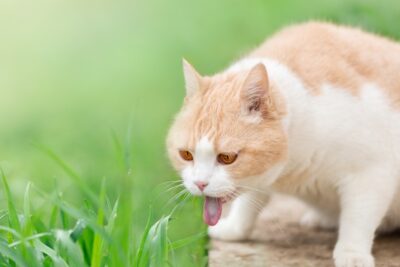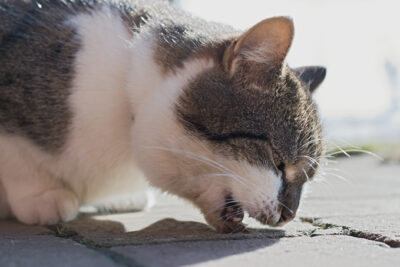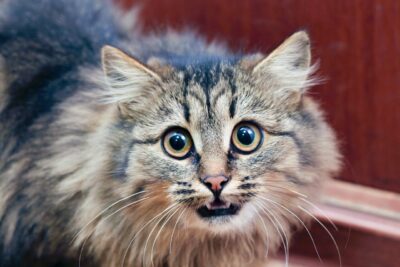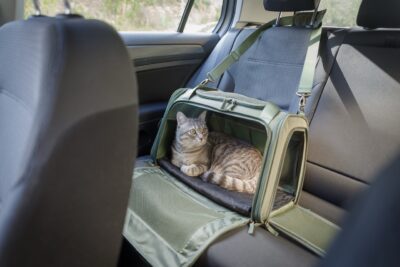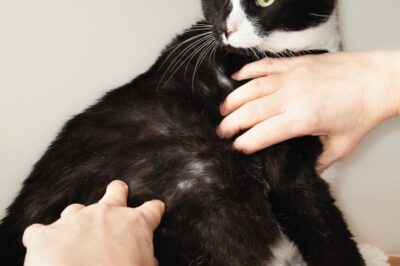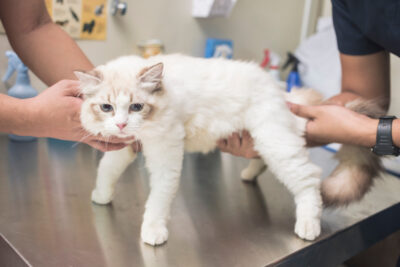Vestibular Disease in Cats

Overview
If you have a cat at home, you’ve probably admired their agility — how they jump, run, pounce, and take off at the speed of light! So what happens if you notice a change — your cat is leaning toward one side, sometimes falling over, stumbling a bit? This would worry any cat parent. Vestibular disease in cats is not as common as vestibular disease in dogs, but when it happens, your cat needs a lot of support. Read on to better understand this disease and what may have caused it.
What Is Vestibular Disease in Cats?
Vestibular disease is a set of symptoms that occurs when one of the two places that control balance is inflamed. One location is the inner ear; the other is the brainstem, a small and very important part at the bottom of the brain. The brainstem has nerve connections going to the spinal cord and the cerebellum, the part of the brain responsible for muscle movement and balance at the back of the brain.
When the inner ear or brainstem is affected by inflammation or tumors in the surrounding area, your kitty cannot balance well. Their muscles will move differently, causing leaning or falling over, and their eyes may move differently when the body changes position.
What Causes Feline Vestibular Disease?

Feline vestibular disease can occur in cats of any age, breed, or sex, although some of the causes are more common in certain ages. The most common causes of vestibular disease in cats include the following [1]:
Inner ear disease
Otitis media (middle ear inflammation) and otitis interna (inner ear inflammation) are the most common causes of feline vestibular disease.
Idiopathic vestibular disease
Idiopathic means that the cause of disease is unknown. It occurs in all ages of cats. Oddly, this is diagnosed most frequently in the summertime.
Cancer
Cancer in the brain, or less often in the bones of the skull or outer lining of nerves, can cause vestibular disease. This is more common in older cats.
Meningitis
Meningitis is inflammation of the outer lining of the brain and spinal cord. There are many causes of meningitis, but the most common cause leading to vestibular disease is feline infectious peritonitis (FIP), a viral infection usually diagnosed in very young cats and old cats. Another cause is bacterial infection around the brain.
Nasopharyngeal polyps
A polyp is a type of mass that grows when an area is inflamed over a long period of time. These masses can grow in the inner ear or nasal cavity, but the inner ear polyps cause vestibular disease. Cats typically develop polyps when under 3 years old.
Thiamine deficiency
Cats may not have enough thiamine, or vitamin B, when they are not fed balanced diets. Alternatively, severe liver or gastrointestinal (gut) disease can lead to insufficient thiamine because the body cannot absorb it well.
There are multiple other causes of vestibular disease, but they are quite rare. Some medications are toxic to the inner ear and can cause vestibular disease, especially aminoglycoside antibiotics such as gentamicin. Additionally, trauma or stroke can lead to vestibular disease.
While the most common causes of vestibular disease occur in any breed of cat, certain breeds, such as Siamese, Burmese, and Tonkinese, can be born with congenital vestibular disease, typically noticeable around 3 to 4 weeks of age.
Cat Vestibular Disease Symptoms

The most noticeable symptom of vestibular disease in cats is that your cat is not walking normally and is appearing wobbly. Ataxia is the primary symptom of vestibular disease and means the body cannot coordinate its movements. This can be described in many different ways, such as:
- Cat walking in circles
- Cat walking sideways
- Cat falling over (might be more common to one side)
- Cat losing balance (might be more apparent in the hind legs)
Other symptoms that may be noted besides walking abnormally include:
- Nystagmus in cats (when the eye is making small, quick, repetitive movements)
- Cat head tilt
- Head twitching
- Swinging the head back and forth in dramatic movements
- Discharge from the eyes or nose
- Horner’s syndrome (third eyelid raised and the pupil of the eye is very small/skinny)
- Changes in behavior (such as not very aware of surroundings)
- Seizures
Diagnosing Vestibular Disease in Cats
Generally, vestibular disease is diagnosed based on thorough examination by a veterinarian with a special focus on the neurologic system, which tests balance and responses by various nerves. If your cat has the symptoms as listed above, then vestibular disease is present. To find the cause, specific testing may be required.
Inner ear disease may be visible when your veterinarian looks into your kitty’s ears with an otoscope during a physical examination. X-rays can show changes in the bones of the skull or severe changes of the middle ear. However, X-rays are not as useful as advanced imaging like computed tomography (CT), which is better for bony structures, or magnetic resonance imaging (MRI), which is better for evaluating soft tissue like the brain. Advanced imaging requires anesthesia and a trip to a specialist. To look for FIP, including cerebrospinal fluid (CSF), testing can be done on fluid from the body.
Bloodwork may be done to assess overall health and look for metabolic changes that need treatment. Additionally, if your veterinarian suspects a thiamine deficiency, a blood test can specifically measure the amount of thiamine in your cat’s bloodstream.
Vestibular Disease in Cats Treatment

Treatment depends on the underlying cause. Inner ear disease might require treatment including anti-inflammatories and antibiotics, or possibly ear medication if the outer ear canal is also affected.
It’s unlikely that cancer is treatable, but it depends on the type. A new medication on the market is available for treatment of FIP virus, but relapse and need for multiple treatments is more common if a cat shows neurological signs, such as having vestibular disease. Polyps often decrease in size slightly with steroids, but surgery to eliminate them is best. Thiamine can be supplemented by an oral pill or subcutaneous injections for kitties who have a deficiency.
In most cases, supportive care at home is necessary until your kitty is feeling better and can take care of themselves. Cats who are off-balance with vestibular disease may be nauseous due to feeling dizzy, like a person with vertigo. If your kitty is drooling or not eating as well, anti-nausea medication is a good idea. If your cat can’t make it to the litter box or gets really messy while using the box, simply keeping them clean is part of supportive care. Your cat may also need help just eating food and should be housed in a place where they cannot climb or jump down from any distance.
Prognosis
Cats with idiopathic disease or inner ear disease tend to have a good prognosis, meaning they will live a full life. Most of these cats see resolution of vestibular signs after several weeks, or a gradual decrease in symptoms. With long-term management, cats with polyps have a fair-to-good prognosis, even if the polyps are not removed. If the disease is caught early and cats are given treatment, those with thiamine deficiency have a good prognosis. Some of the causes, such as FIP and cancer, hold a much more serious, poor prognosis.
Cost to Treat Cat with Vestibular Disease
Supportive care at home may cost a couple hundred dollars per month for potty pads, extra food, anti-nausea medications, and fluids. The exact treatment of the underlying cause varies widely in price. Treatment may consist of minor surgery (like removal of polyps) or thiamine supplementation, which may be several hundred dollars. Some treatments for FIP and cancer cost thousands of dollars. The most expensive part of bringing your cat to a veterinary office is the tests. If an MRI or CT is done, it will likely cost a couple thousand dollars.
How to Prevent Feline Vestibular Disease

There are two ways to prevent vestibular disease in your cat. First, feed them a well-balanced diet that is intended for cats. Avoid vegetarian, raw, or homemade diets, as these are extremely difficult (if not impossible) to provide the nutrition your cat needs.
If your cat is showing any symptoms of ear discomfort, such as frequent scratching at the ears — especially if fur is missing and/or skin is red or damaged — contact your veterinarian. Treating an external ear infection early may possibly prevent the middle ear canal from becoming inflamed as well.
Vestibular Disease in Cats FAQs
Can vestibular disease kill a cat?
This is possible, for example, if your cat stumbles and falls from somewhere high up or suffers severe trauma because of their inability to walk well. Some causes of vestibular disease have a higher risk of killing a cat, such as cancer or FIP.
What toxins cause vestibular disease in cats?
Specific medications can cause damage to the inner ear and thus vestibular disease. It is very rare, but the most common toxic effect is from aminoglycoside antibiotics being put into the ear, like gentamicin. Metronidazole is an antibiotic given by mouth that in very rare cases can cause damage to the inner ear.
Is vestibular disease in cats painful?
Vestibular disease itself is not painful, but some of the underlying causes are. Inner ear inflammation and swelling around the brain can be very painful.
How long does vestibular disease last in cats?
Vestibular disease can happen suddenly and last a few days before slowly resolving over several weeks. It can also come on gradually, over multiple months, and last a lifetime.
Reference
- Grapes NJ, Taylor-Brown FE, Volk HA, De Decker S. “Clinical reasoning in feline vestibular syndrome: which presenting features are the most important?” Journal of Feline Medicine and Surgery. 2021;23(8):669-678. doi:10.1177/1098612X20970869
